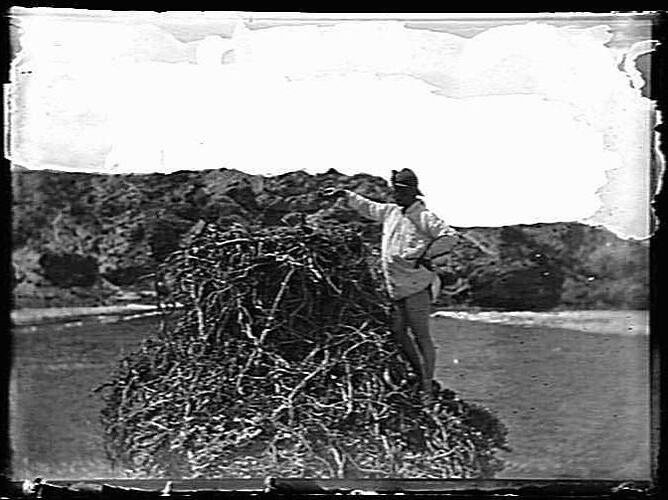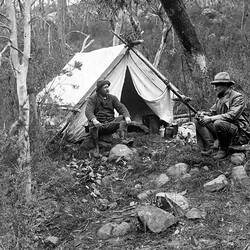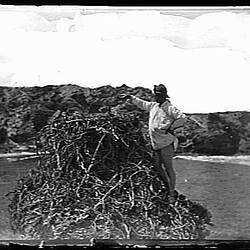PANDION HALIAETUS (sub-species) LEUCOCEPHALUS, GOULD.-(6)
WHITE-HEADED OSPREY
Geographical Distribution.-Australia coast in general and Tasmania; also New Guinea and Moluccas.
Nest.-A structure of great size, about four-feet high by the same dimension in breadth, built of sticks, with a shallow cavity lined with seaweed. Usual situation an inaccessible rock or island, but low timber near water is sometimes chosen.
Eggs.-Clutch, three to four; shapely or roundish oval in form; texture of shall, somewhat granulated, surface of soft appearance and usually lustreless; ground-colour, buffy or yellowish-white. In three examples of a splendid set taken from an aerie near the mouth of the Margaret River (W.A.), the markings are mostly large and bold blotches of rich, dark, purplish-brown, more numerous about the upper half of the egg, and forming a large confluent patch almost black on the apex; while the fourth egg is not so heavily blotched, the markings of pinkish-brown, intermingled with dull purple, being lighter and more evenly distributed over the surface; inside lining of the shell, when held up to the light, dull yellowish-green. Dimensions in inches: (1) 2.48 x 1.77, (2) 2.44 x 2.8, (3) 2.42 x 1.79, (4) 2.42 x 1.74.
Observations.-The Osprey in maturity is somewhat like the Sea Eagle, with brownish coat and white underneath parts, but in the Osprey the white head is mottled with a few dark feathers and the chest with brown, cere lead-colour, bill black, feet bluish-white, and bright eyes of yellowish-orange. It is a smaller bird than the Sea Eagle, as the dimensions show-Length, 21 to 24 inches; wing, 19 inches; tail, 8 ½ inches.
My only experiences with this expert Fishing Hawk were in Western Australia. With departing daylight we arrive at Wallcliffe, the homestead of Mr. A. J. Bussell, on the Margaret River. By kind invitation we remain here a day, and I improve the occasion by exploring for objects of interest, and am not disappointed. I learn there is a Fish Hawk or Osprey's nest a mile or so up the coast. Ah! Methinks, what a rare subject for the camera. Good-naturedly Mr. Bussell promises to pilot Mr. Mansfield and myself to the aerie in the morning, and at the time appointed away we go joyfully. We are suddenly confronted by the broad stream, seventy or eighty yards across, of the Margaret River. "How are we to cross, Bussell?" I inquire. "Wade, of course," was the reply. "May I ask is it deep?" "Only up to your armpits," was the anything but reassuring answer, and now occurred to me the reason of Mr. Bussell's thrusting a towel into his coat pocket before leaving the house. However, there was no help for it. Bussell soon led the way with his undergarments gathered under one arm, his boots in his teeth, and his unmentionables held high in the air with the other hand. When Mansfield, who is shorter in stature, reaches the centre of the stream, there is scarcely anything visible except his broad-brimmed straw hat of sombrero proportions. Oh, if I only had my camera on shore, instead of upon my head, with these cooling waters lapping around my ribs, what a comical picture I might have taken of the pair, I thought. We are soon dressed, and tearing over scrubby sandhills, reaching the ocean just in time to see the steamer "South Australian" rolling by on a heavy swell. We round a sharp corner, when Bussell suddenly exclaims, "There's the Fish Hawk's nest!" Sure enough it was, and a very conspicuous object, built on a small isolated rock, with the birds posing near. Bussell, who was fuller of actions than words, commenced to "peel off" again, and I quickly learnt there was to be another Margaret River episode, as the blue waters rolled between the rocky aerie and the land. But the thought of a successful photograph, and perchance a clutch of rare eggs, are too much when laid in the balance with temporary discomforture, so I am soon semi-clad, following my guide with uncertain gait over the sharply-pinnacled reefs. Fortunately, the tide is low. Breathless we reach the aerie, which is only tenanted by fledglings. The camera is quickly adjusted, the tripod resting amongst brittle saltbush, where young gulls were hiding. While Bussell examines the young Ospreys, the drop-shutter descends, and he is immortalised. The illustration give a capital idea of the nest, with the mainland as a background. The nest, with slightly hollowed top, is about 4 feet high, with a circumference of about 13 feet, constructed of sticks and roots, and situated about twenty-five feet above high-water mark. The old brids now circling on high, where their white heads are just distinguishable from their dusky body against the azure sky, are uttering piercing cries of solicitude for the safety of their helpless offspring below.
The exact date of the foregoing was the 5th November, 1889. Mr. Bussell compensated for my disappointment at finding only young by presenting me with a full clutch of the unusual number of four eggs that he had removed from the Osprey's aerie the previous season.
On 21st December I examined another Osprey's aerie containing fully-fledged young on Direction Rock or Byers Island, off Rottnest Island. The nest was at one end of the rock, while the other end was occupied by scores of handsome Crested Terns (Sterna bergii), all prosecuting their task of incubation, perfectly fearless of their large rap-torial friends. I thought this somewhat remarkable, for, dearly as the Osprey loves fish, it is by now means adverse to fowl. Time did not permit of my visiting another aerie which was reported to me on Rottnest Island, but we possess good Gilbert's record of measuring one there fifteen feet in circumference.
References
Transcribed Archibald James Campbell. Nests and Eggs of Australian Birds, including the Geographical Distribution of the Species and Popular Observations Thereon, Pawson & Brailsford, Sheffield, England, 1900, pp.40-41.
More Information
-
Keywords
-
Authors
-
Contributors
-
Article types


